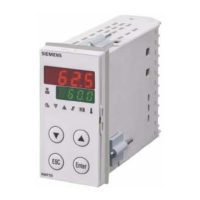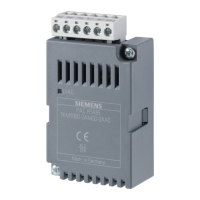67/126
Siemens Building Technologies Basic documentation RVD240 CE1P2384en
HVAC Products 16 D.h.w. heating 27.05.2004
16.3.5 Flow switch
If desired, a flow switch can be fitted in the heat exchanger’s cold water return. For this
purpose, the RVD240 provides digital input H5, which is to be configured on operating
line 55.
The flow switch improves the performance of the heat exchanger’s control. It indicates
to the control system when a demand for heat can be expected. When there is no flow,
it is possible to ensure that the d.h.w. delivered will not be too hot.
The use of a flow switch is especially recommended in the case of smaller plants (sin-
gle-family houses, etc.).
Fault status supervision is not possible since short-circuits and open-circuits are permit-
ted statuses.
Functions that are dependent on the flow switch are the adjustable load limit and the
child-proofing facility (refer to subsection 18.7.3).
16.3.6 Compensation of heat losses through control
Generally, heat losses due to d.h.w. consumption are always compensated for through
control.
In addition, when using a flow switch and a circulating pump, it is possible to configure
whether the control shall also be active outside periods of d.h.w. consumption, that is,
whether heat losses due to radiation, circulation, etc., shall be compensated for.
The configuration is to be made on operating line 54.
If a flow switch is used, the primary valve will temporarily be controlled by an opening
signal at the beginning of d.h.w. consumption, and by a closing signal at the end of
d.h.w. consumption.
To ensure that no excessive temperatures occur and the response of the control is fast,
an immersion sensor must be used in the case of configurations with no flow switch,
since that sensor immerses into the heat exchanger (e.g. type QAE21.93).
2383S31
B32
2383S32
B32
Plant without flow switch Plant with flow switch
Operating
line 55
Operating
line 54
Function Flow switch circulating
pump
0 No
≠4
1, 2, 3
Full compensation of heat losses
No
Yes
4 0, 1 No compensation of heat losses No No
4 2 Partial compensation of heat
losses, maximum flow temperature
reduction by 20 % permitted
Yes Yes
4 3 Full compensation of heat losses Yes Yes
Explanations relating to the settings on operating line 54:
There is no d.h.w. heating when no d.h.w. is consumed. This is true also when the cir-
culating pump runs. Since heat losses are not compensated for, the d.h.w. temperature
will drop to the room temperature level eventually.
General
Caution
Mode of operation
Settings 0 and 1

